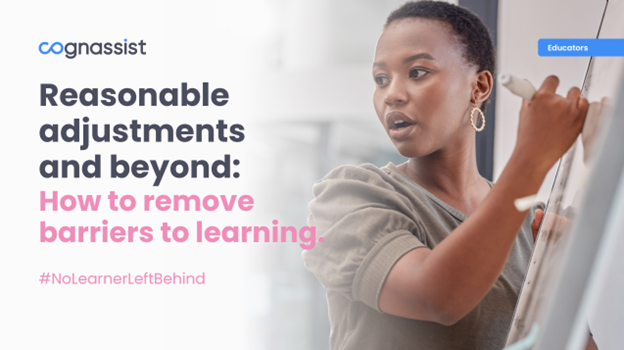Government rules on reasonable adjustments: Q&A with ESFA and IfATE
What are the rules on reasonable adjustments?
Making sure your support provision, including reasonable adjustments, are compliant with Government rules and regulations is a must.
But many providers are nervous about claiming Government funding due to the risk of clawback.
In our latest reasonable adjustments panel, we wanted to break down the rules on reasonable adjustments and the ESFA regulations around learner support to give some clear answers.
This second panel was all around compliance and it’s now available to watch on demand.
Thanks to our panellists:
Karen Bennett, Senior Policy Lead at the Education & Skills Funding Agency (ESFA)
Tina Bhambhra, Senior Assessment and Quality Manager at the Institute for Apprenticeships & Technical Education (IfATE)
Chris Quickfall, CEO at Cognassist
Dr Louise Karwowski, Director of Education at Cognassist and our host.
If you missed it, you can take a look at our highlights from the first panel on implementation.
And again, it was brilliant to hear so many questions and comments from our audience.
So let’s get into it!
Reasonable adjustments and funding claims will rely on your ability to identify learners who need support, and this will be a multi-step process.
So it’s helpful to look at what the guidelines are around identifying needs and what that need actually looks like.
Skip ahead to the audience Q&A or keep scrolling to read the best bits on what our panellists had to say…
How do we define a need?
Chris: Yeah, it’s a question we’re often asked actually, ‘what is the definition of a need?’
The 1996 Education Act defines a need as a significant learning difficulty when compared to the majority of your peers of an equivalent age.
So it’s a significant difficulty.
And then we take that significant difficulty and we look at how that’s defined in a cognitive environment.
The British Psychological Society and the World Health Organisation defines significance as being more than one standard deviation below the norm of a population distribution.
A norm is 100 on the standard score and both the WHO and the British Psychological Society deem that more than one standard deviation below the average and that’s a learning difficulty. If it’s more than two standard deviations below that norm, it qualifies as a learning disability.
The guidance and rules on reasonable adjustments changed in 2019, what was the driver for that change?
Karen: So you’ll find on the Institute for Apprenticeships website some new guidance around reasonable adjustments and I think the reason for this is actually to provide more guidance given the move in apprenticeships from frameworks to standards.
Obviously, that change to standards brought with it the new assessment process at the end-point assessment process.
Therefore, it was the right thing to do to provide much more detailed guidance as to how training providers, end-point assessment organisations, the employer and the apprentice could work together to manage reasonable adjustments.
The guidance covers what reasonable adjustments are, how they should be put into place for funding and also includes the Reasonable Adjustments Matrix. [download a copy of the Matrix]
It’s very much there to support everybody involved in that end-point assessment process within apprenticeships.
Would you say the auditors are being educated on reasonable adjustments?
Karen: Absolutely.
So when we talk about the EQA process, the external quality assurance process, every apprenticeship standard will have an EQA in place.
Part of the external quality assurance will be very much around looking at those reasonable adjustments and making sure that they are audited in a consistent and very much standard process. That’s absolutely something in place.
Tina might be able to expand on that more than me as well.
Tina: Thanks, Karen. Just to add to that, I think it’s important to appreciate that from the EPA’s perspective we have external advisers who bring their experience.
Also the general public have the opportunity to comment on the apprenticeships and EPA as part of the development.
We’re bringing in and listening to all contributions before approving an EPA or a standard apprenticeship.
Do you think they could be more consistency around what good evidencing looks like?
Tina: I think it’s important that we realise first of all that it’s a collaborative effort towards building consistency around what good evidence should look like.
It’s everybody, right from the training provider to the EPAO. It’s not just one party that can bring that.
It would have to be something that’s collaborative. Sharing good practice would build towards that, sharing suggestions, ideas of how things are being done in compiling the evidence together would work really well for something like that.
I don’t think it’s something that one party could deliver. It would deviate between sectors, occupation and what works for each. You can really break it down.
Karen: One of the immediate things that sprung to mind when you talked about that is around the fact that every situation is different.
Every case is different so we will learn about this. It’s a learning journey.
It is a collaborative approach.
What I would be encouraging everybody to be doing, all stakeholders, is to be learning. Saying, “Ok, we’ve gone through this case, we’ve gone through this reasonable adjustment, what have we learned?”
Maybe this is something we should be talking about more. What works, what didn’t work. What could we have done differently?
For me, it’s collaborative.
Not being afraid to talk about what we could have done differently and share our learning as well.
What a great segway to look at our audience Q&A and share some thoughts.
Audience Q&A
Here are just a few of the fielded questions that really stood out.
In my experience, provision could be very inclusive and adjustments are put in place throughout the apprenticeship to support the learner, whether they have a learning difficulty or not.
How can we justify LSF1 if we are making some reasonable adjustments anyway?
For example, extra functional skills support, dedicated time in sessions to work on organisational skills, preparation materials being sent every learner before training sessions.
Karen: I think it meets the requirements of the funding and the reasonable adjustments are there, then processes have to be followed. If it meets the criteria, then it meets the criteria. And it is very much a case by case basis.
Chris: I would say as well, that is top line best practice. Every learner should have reasonable adjustments in a learning environment. There are really two types of reasonable adjustments: there’s a learning adjustment and then there’s an assessment adjustment.
In a learning environment, everybody should have adjustments because every brain is different and we all have strengths and weaknesses.
If we go back to the definition of the need. We’re saying that at a specific point in the Education Act that need falls into being a significant need and qualifies as a learning difficulty. At that point, you can claim funding for those reasonable adjustments.
Do you think auditors have enough information to know the difference between a need in cognition and a difficulty with a functional skill, for example? Or are these things put in the same bucket?
Karen: I think they’ve got enough information. It’s all around the process.
If everyone’s doing this from the start. Where they’re going through the process, they’re looking at the guidance – it’s all about documenting.
I think it’s really important for the EPAOs, the training providers, the employers to be documenting what’s happened, what the reasonable adjustment is, what actually taken place.
Then I think with the auditors, when they’ve got the background and they’re following the guidance then I think that’s appropriate.
I would just highlight the importance of the documentation process. Don’t make any assumptions. You need to leave a really good audit trail and that’s really, really important.
How do I encourage more assessors to record the support they give to apprentices so I can claim funding?
Karen: I would probably get them to do a call, get them to do some sort of teaching session. Talk to them about the importance of it, share our learning and put in some form of process to ensure they really are doing what we need them to do and talking about it right at the beginning of the process.
Chris: When we’ve worked with organisations, we had this exact challenge.
There is almost a silver bullet here. When evidence is mapped into the performance management process, so there are monthly reviews of tutors to run through the evidence and make sure it’s been documented. This seems to be the best way to change tutor behaviour and get the evidence documented throughout.
Monthly performance management reviews seem to solve that problem.
How important is it to create an individual plan of support with the learner from a funding perspective? And does this plan need to be agreed with the learner?
Karen: I’m sure Chris can comment as well but I would say reasonable adjustments or not, it’s really important to make a plan.
As Chris says, everybody’s got reasonable adjustments so I think it’s absolutely critical to make plan with the learner. That should be done for all apprentices. In my experience as an employer, that’s exactly what we would have done.
Chris: I agree. I think there’s also an onus on the learner themselves to take ownership of this. For them themselves to code the strategies into their behaviours.
The best way to do that is through conversation with the learner. It’s really important that it’s a two-person process.
Karen: Chris I think you’re really right.
We would be wrong to get this far into this discussion without talking about that.
You’re absolutely right. There is a real onus on the individual to talk about that. That’s something I’ve learned. I can’t rely on other people to try and guess what my reasonable adjustments might be.
One of the things I’ve learned, and it’s probably taken me a long time to learn it and I’m still learning, there is an onus on me as an individual to be honest about it as well.
A lot of people do feel uncomfortable about having this conversation.
So how do you speak to colleagues and other trainers about learner’s needs in front of them without making them feel uncomfortable?
Chris: Really good question. Have we already had the conversation with the individual so they’re aware that this need is present and it’s been accepted across both parties here? That would be a real foundation to put in place.
You can almost sandwich that conversation by talking about your own strategies and then pass on to the learner and talk about their strategies. Maybe discuss where you can share strategies.
Louise: I think working at Cognassist is a really good example of this because you’re very open about your dyslexia, with the needs posed by it and your strategies.
We share them openly in the business and it’s a comfortable arena for any new started coming to realise that it’s widely accepted to have a need to be open about it.
I think it’s about creating that environment from the start.
Karen: One of the words you said there was “open”. For me, it’s also about open questions with the learner around how they’re feeling.
Is there anything they feel that could make it more challenging for them?
I’d ask really open questions, make them feel comfortable and be open as well.
As you can see, another incredibly informative chat around reasonable adjustments. And these are just the highlights! Please do watch the full event.
But wait… There’s more
You can also read about the next panel in the series on execution to get the employer perspective from BT.

Helen
Science Communications Manager
Download our free whitepaper
In this white paper, we explore reasonable adjustments in detail and give you the must-have information to drive learner success.
You’ll learn:
- What are reasonable adjustments?
- Why reasonable adjustments are crucial for learner success
- Your responsibility as an employer, learning provider, EPAO or awarding organisation
- The first steps for implementing reasonable adjustments in your organisation

